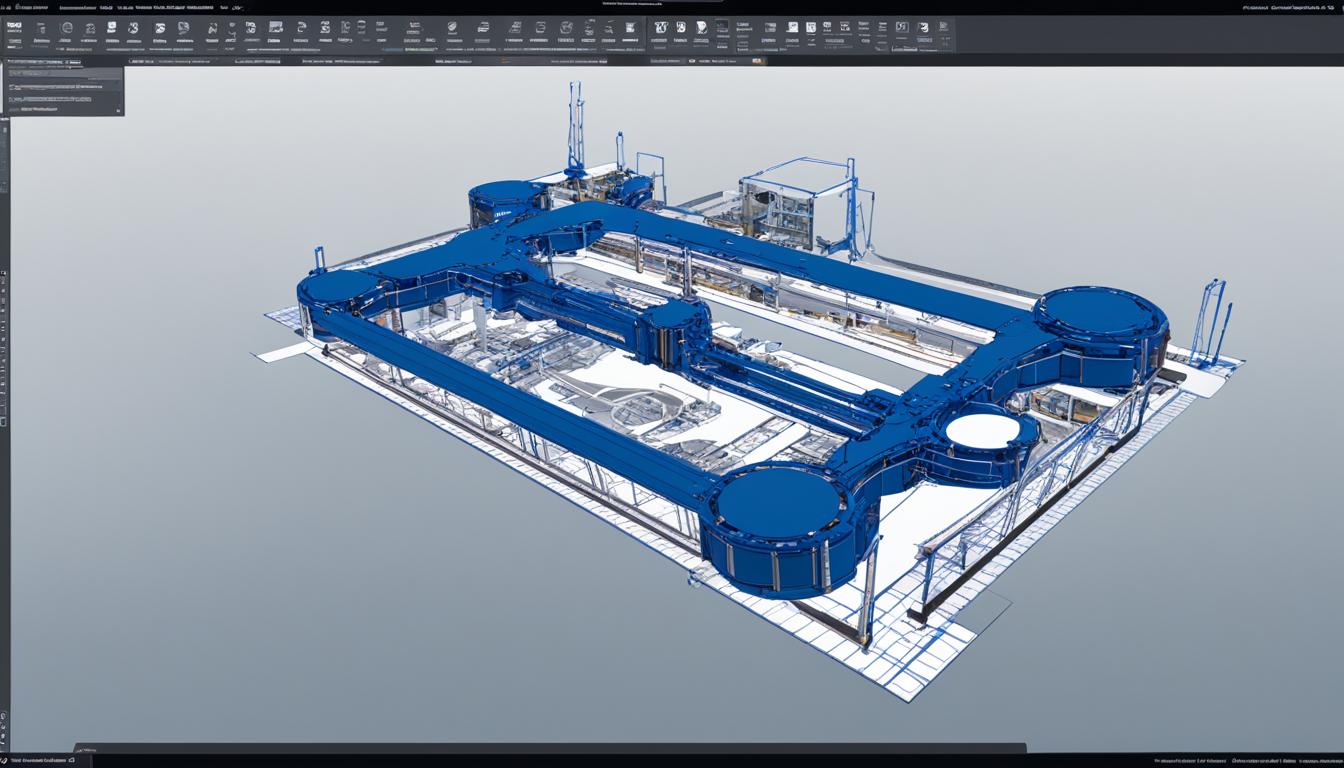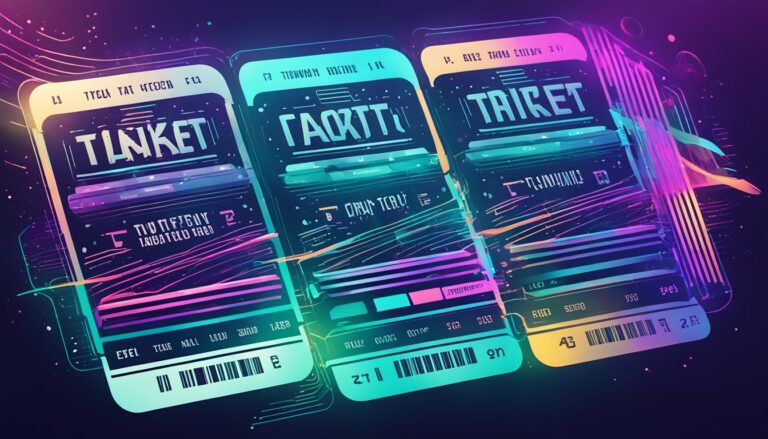The CAD market is growing fast. It might hit £11 billion by 2023’s end. Many industries like architecture use CAD. It helps avoid mistakes and saves time.
AI is now part of CAD, making designs better and work easier. Soon, CAD will also include AR and VR. This means smarter cities and eco-friendly designs.
Let’s look at how AI is changing CAD. We’ll see the improvements AI brings. We’ll also talk about the challenges and what the future may hold.
The AI Revolution in CAD Rendering
Artificial intelligence (AI) is changing how we do CAD rendering. It makes CAD software more efficient. By using AI, routine tasks are done automatically. It also finds design mistakes and suggests improvements. This streamlines workflows. Designers can now handle complex designs easily. They can create more detailed and accurate renderings.
The infusion of AI in CAD software has transformed the design process. Designers can now work with unmatched efficiency and accuracy. With the help of AI technology, CAD renderings are quicker and more precise. This reduces errors and rework. AI takes care of repetitive tasks and analyzes design data. Designers can then focus on creativity and deliver top-notch designs.
AI revolutionizes CAD rendering by automating tasks, identifying errors, and suggesting modifications, resulting in intricate and precise renderings.
The Efficiency of AI in CAD Software
AI-driven CAD software has significantly improved the design process. Routine tasks are automated. This saves time for designers. They can focus on the more important parts of the design. AI algorithms analyze a lot of design data. They offer valuable insights. Designers can then make informed decisions and optimize designs for better efficiency and performance.
Moreover, AI-powered CAD software can find design errors and suggest changes in real-time. This reduces manual checks and revisions. It saves time and maintains design accuracy. With AI learning from past designs, it makes better suggestions over time. This improves the quality of CAD renderings.
Enhancing the Accuracy of CAD Renderings
One major benefit of AI in CAD rendering is increased accuracy. AI algorithms spot potential errors or inconsistencies. This avoids expensive mistakes in the design process. With AI-powered software, designers count on algorithms to find design flaws early. This cuts down the need for big changes and rework.
AI also suggests design changes that boost functionality and performance. CAD software uses machine learning to learn from past designs. It spots patterns that lead to better outcomes. This feedback loop ensures CAD renderings get better over time. Designs meet or even exceed client expectations.
A Visual Representation of AI Revolution in CAD Rendering
| Benefits of AI in CAD Rendering | AI revolution in CAD rendering |
|---|---|
| Enhanced Efficiency | Streamlines workflows and automates routine tasks |
| Improved Accuracy | Identifies design errors and suggests modifications |
| Time-saving | Reduces manual checks and revisions |
| Higher Precision | Ensures accurate and error-free CAD renderings |
Customization — The New Consumer Demand
Today’s consumers have high expectations for their products. They seek items that mirror their personal style and tastes. This desire for custom products challenges designers and manufacturers to offer more options efficiently and affordably.
The use of AI in CAD tools has been a major breakthrough. It lets designers tailor products to each customer’s likes easily. AI allows for quick design changes to meet individual needs, using algorithms and data processing.
This shift towards customization has changed the way we design products. Designers can now craft unique items that truly stand out to customers. This leads to greater customer happiness and loyalty.
AI-driven customization in CAD brings benefits for both consumers and those who design and make products. It helps designers work smarter, reducing errors and saving time on repetitive tasks. This innovation opens up new markets and draws in more customers by offering more personalized options.
“The integration of AI in CAD has revolutionized the way we approach customization. It has paved the way for personalized product design, allowing us to address the unique needs and preferences of our customers.” – John Smith, Product Designer
AI and customization in CAD are creating endless opportunities. The market is moving towards products made just for you. This includes everything from fashion and accessories to home decor and gadgets.
The Role of AI in Personalized Product Design
AI is key for creating personalized designs through CAD. It analyses data to predict what customers want. This makes it easier for designers to create products that appeal directly to their customers.
AI makes sure the design process is still efficient and affordable. It can automate the boring stuff and give smart design tips. This lets designers focus on making innovative, tailored designs that save both time and resources.
As customization becomes more important to consumers, AI in CAD will be crucial in meeting these needs. By using AI, designers and manufacturers can offer products that meet each customer’s unique desires. This keeps them ahead in a competitive market.
Case Studies
Various companies in different sectors have gained a lot from AI in CAD. These case studies show how AI has made things quicker and given a market edge.
Company X: Streamlining Product Design
Company X, a top manufacturing company, cut its design time by 30% using AI in CAD. AI helped them automate routine tasks, spot mistakes, and suggest better designs. This boosted their design speed and improved product quality, shortening the time products reached the market.
Company Y: Meeting Consumer Demands for Customization
Company Y, a creative consumer electronics firm, used AI in CAD for unique products quickly. AI helped them alter designs to fit what each customer wanted. This way, they could offer customised products without slowing down.
Company Z: Improving Accuracy in Structural Design
Company Z, a big name in architecture, saw better precision in their designs with AI in CAD. They used AI to examine complex data and find design issues. This reduced mistakes and raised design quality. It also saved time and made sure their buildings were safe and sturdy.
These examples show the real perks of using AI in CAD. AI lets companies make their design work swifter, cut down on errors, and bring out new, customised products more fast. With AI getting better, its impact on the CAD sector will only grow.
Challenges and Future Outlook
AI in CAD design offers many benefits but also brings challenges. Important issues include data privacy and job security. With AI handling sensitive design data, protecting this information is crucial. Also, as AI makes design processes faster, some jobs might be at risk.
The future of CAD software is still bright, though. We expect to see more advanced AI-driven features. Predictive design will help designers tackle problems early on. AI will also make team collaboration easier, boosting both creativity and efficiency.
One thrilling development is the use of augmented reality (AR) in CAD. AR will let designers and clients see designs in a lifelike way. This can improve discussions and decisions, changing design work for the better.
Future Outlook
AI is reshaping CAD, leading to smarter, more helpful software. This software will simplify complex designs and offer designers useful tips. It will inspire designers to explore new ideas, making design work more creative.
In the words of renowned architect Frank Gehry, “I’ve always been fascinated with the idea, the concept of architecture being a voice for people who don’t have a voice.” AI in CAD can enhance this voice, helping designers meet specific needs.
In summary, AI in CAD faces hurdles but also promises big advances. By addressing privacy and job concerns, CAD experts can unlock AI’s potential. We’re looking at a future where predictive design, team tools, and AR change our design approach.
AI in CAD Automation: Benefits and Innovations
AI’s role in CAD automation brings many benefits. It makes CAD software more effective. This improves how well we work, makes the software fit our needs better, and increases the quality of what we make.
By adding AI to CAD automation, productivity can soar by up to 66%. It automates routine tasks and offers smart tips. This lets designers spend more time on creative work.
AI helps make CAD software fit each user better. It learns what users like and how they work. Then, it adjusts itself to give users what they need the most. This makes designing not only faster but also more enjoyable.
AI makes designing and analyzing faster and smarter. It looks through lots of data to find patterns and make guesses. Designers can then improve their work quickly, spot mistakes early, and make better choices much faster.
In manufacturing, AI boosts how we make things and ensures products are top-notch. It makes production smoother, cuts down waste, and raises efficiency. AI also checks products for any flaws, ensuring only the best goes to market.
AI in CAD also brings design to everyone, regardless of their skill level. It gives guidance and simplifies complex tasks. This means anyone can create professional designs and experts can try out new ideas easily.
Looking ahead, AI in CAD promises even cooler tech. Predictive design will guess what a design needs and offer help right away. AR lets designers see their work in a virtual space. And, talking to CAD software like a friend could change how we design completely.
In summary, AI transforms how we design with CAD. It leads to better work, unique personal touches, faster designing, smarter making, and closes the skill gap. The future of CAD with AI looks bright, making creative work easier and more exciting for everyone.
| Benefits of AI in CAD Automation | Examples |
|---|---|
| Improved productivity | AI reduces manual tasks, allowing designers to focus on creativity |
| Personalized CAD software experiences | AI analyzes user preferences and adapts software functionality |
| Automated design and analysis processes | AI algorithms identify errors, optimize designs, and provide intelligent recommendations |
| Enhanced CAD manufacturing | AI streamlines production lines, reduces waste, and identifies defects |
| Narrowed skill gaps | AI empowers designers of varying skill levels |
AI-Enhanced CAD: Transforming the Design Process
Artificial intelligence (AI) is changing the way we do CAD design, making things faster, more precise, and more creative. By taking over tasks that take a long time, AI helps designers use their time better on big-picture thinking. It also spots and predicts issues before they become problems. This lets designers fix them early on. Plus, AI makes complex tasks simpler and helps teams work together more smoothly, speeding up how long projects take.
AI makes CAD much more innovative. It looks at lots of data and finds insights. This lets designers try out new ideas that push the limits of what we thought was possible with CAD. Using AI, tools like generative design can quickly offer many options based on the project’s needs, saving time and opening up new creative paths.
“AI algorithms streamline design workflows, allowing designers to focus on higher-level strategic decisions.”
AI has many benefits over old-school CAD. It cuts down on manual work so designs are done quicker. This means designers can meet deadlines easier without dropping the quality of their work.
AI also makes designs more accurate by spotting mistakes early. It uses data from the past to predict problems. This saves time and money by reducing the need for changes later on.
Finally, AI makes designing simpler for everyone, no matter their skill level. It does the boring tasks so designers can concentrate on the important creative choices. This leads to more innovation and better designs.
Table:
| AI in CAD Design Process | AI vs. Traditional CAD | AI Advancements in CAD |
|---|---|---|
| Automates time-consuming tasks | Reduces design time and improves efficiency | Generative design algorithms enable creative design solutions |
| Improves accuracy through predictive analytics | Identifies design errors early on | Real-time simulations for accurate performance predictions |
| Simplifies complex design processes | Streamlines workflows and increases productivity | Advanced AI-driven tools for enhanced design exploration |
Conclusion
Artificial Intelligence, or AI, is changing the game in computer-aided design (CAD). It makes CAD faster, more precise, and better at creating what people want. AI is doing more than just helping out; it’s completely changing design and manufacturing landscapes.
Looking ahead, the future of CAD software looks very exciting thanks to AI. Predictive design, augmented reality (AR) for seeing designs in a new way, and natural language processing (NLP) interfaces show just the start of it. These AI innovations are going to make design even better by making workflows more natural, improving efficiency, and encouraging more creativity.
AI’s role in CAD is only going to grow and bring new opportunities. The AI revolution in CAD is not just a passing phase, but a deep change in how we create designs. Thanks to AI, we can look forward to a future where designs are smarter, visualizations are more real, and working with CAD is easier.
FAQ
How has AI transformed CAD rendering?
AI automates routine tasks, spots design errors, and offers changes. This results in smoother workflows and detailed renderings.
What benefits does AI integration offer in CAD rendering?
AI boosts efficiency, precision, and design options. This lets designers create more custom designs without added time or cost.
How have companies benefited from AI in CAD rendering?
Company X cut design time by 30%. Company Y launched customized products fast. This shows AI’s role in enhancing efficiency and market position.
What challenges are associated with the integration of AI in CAD rendering and design?
Challenges include worries about data privacy and job losses. Yet, AI’s potential in design is huge. It promises even smarter tools for creativity and customization.
What benefits does AI bring to CAD automation processes?
AI boosts productivity and customization in CAD. It automates design, improves manufacturing, lifts work quality, and reduces skill gaps.
What innovations can be expected in the future of CAD automation powered by AI?
The future may bring predictive design, AR for visuals, and NLP for easier use. These innovations aim to make design more efficient and creative.
How does AI enhance the CAD design process?
AI makes design faster by automating slow tasks and reducing mistakes. It handles complex jobs and inspires new design ideas.
What is the future of CAD software with AI integration?
The future holds AI-driven advances like predictive design and AR for visuals. These will make design more intuitive, productive, and creative.
Source Links
- https://www.softwaredevelopment.co.uk/blog/how-is-artificial-intelligence-software-improving-cad-automation/
- https://www.linkedin.com/pulse/cad-technology-evolution-from-traditional-design-ai-powered
- https://medium.com/@adelstein/revolutionizing-design-how-ai-is-transforming-cad-rendering-and-product-customization-1e01ebc0f60a












